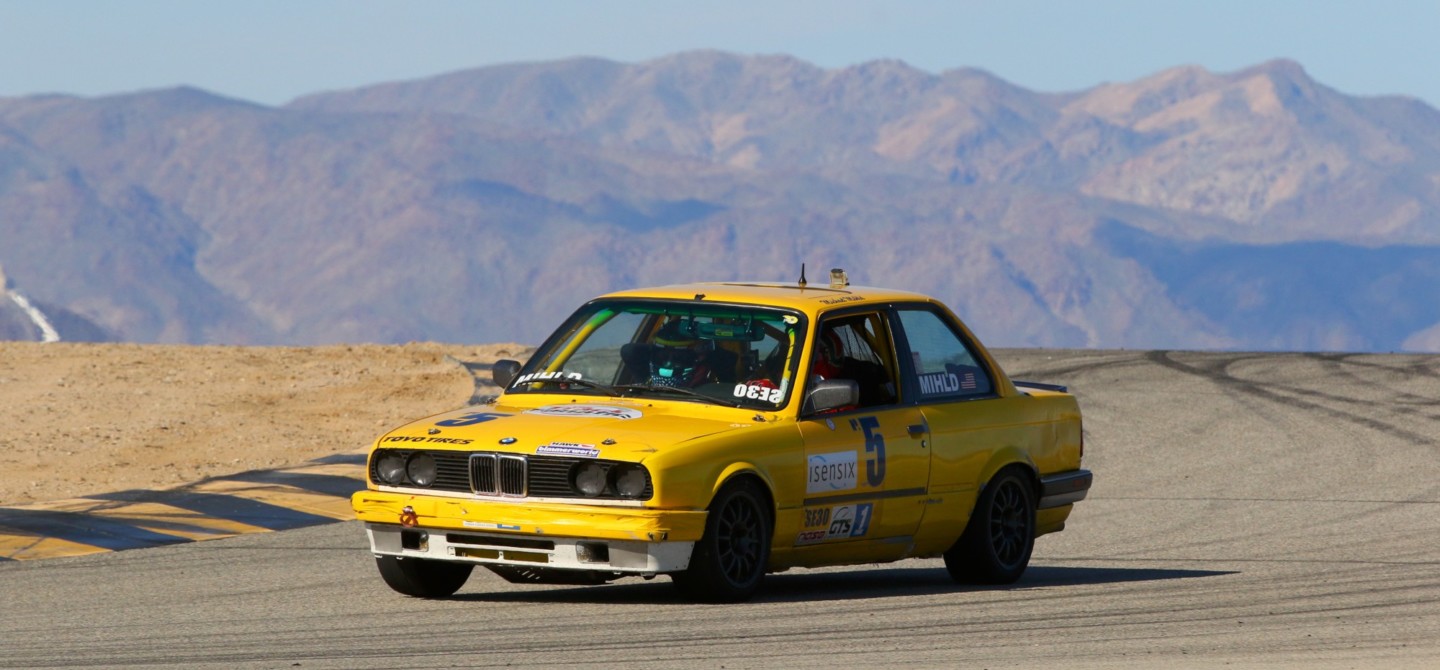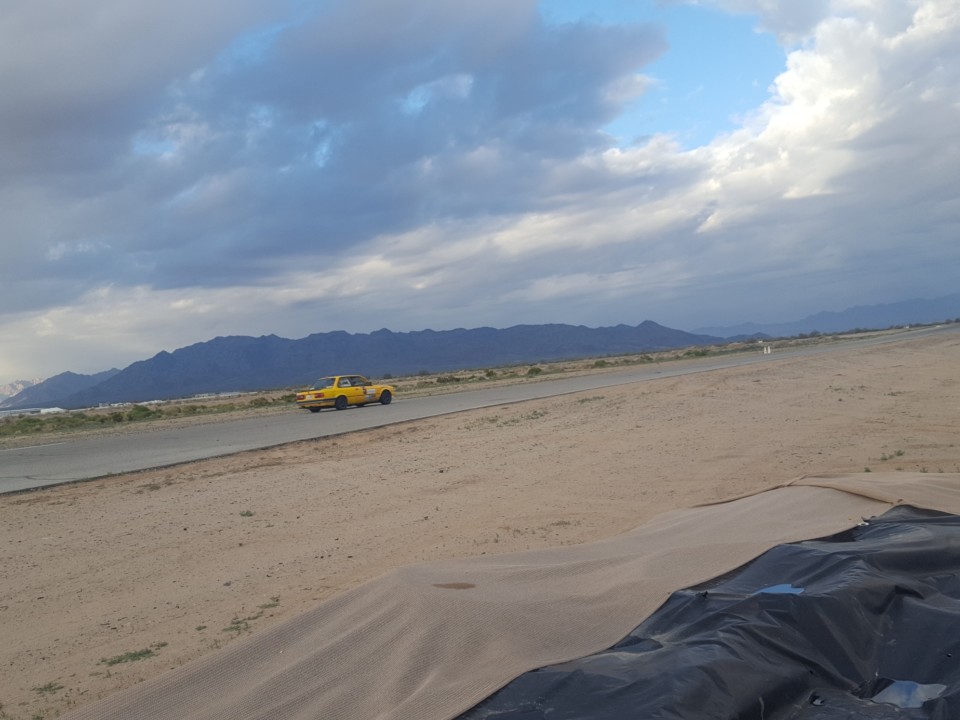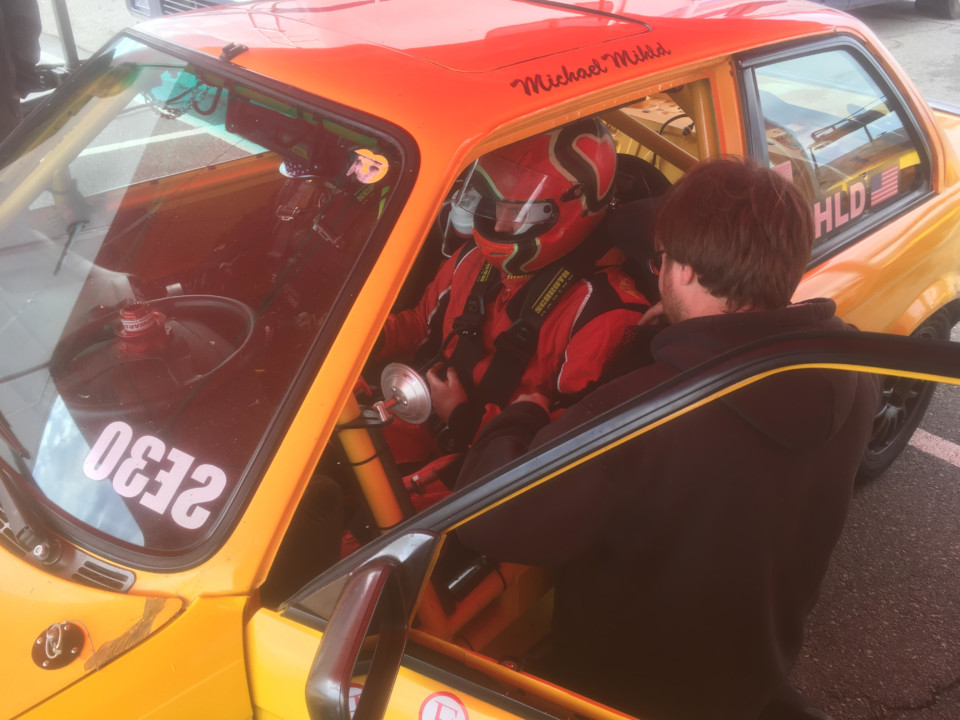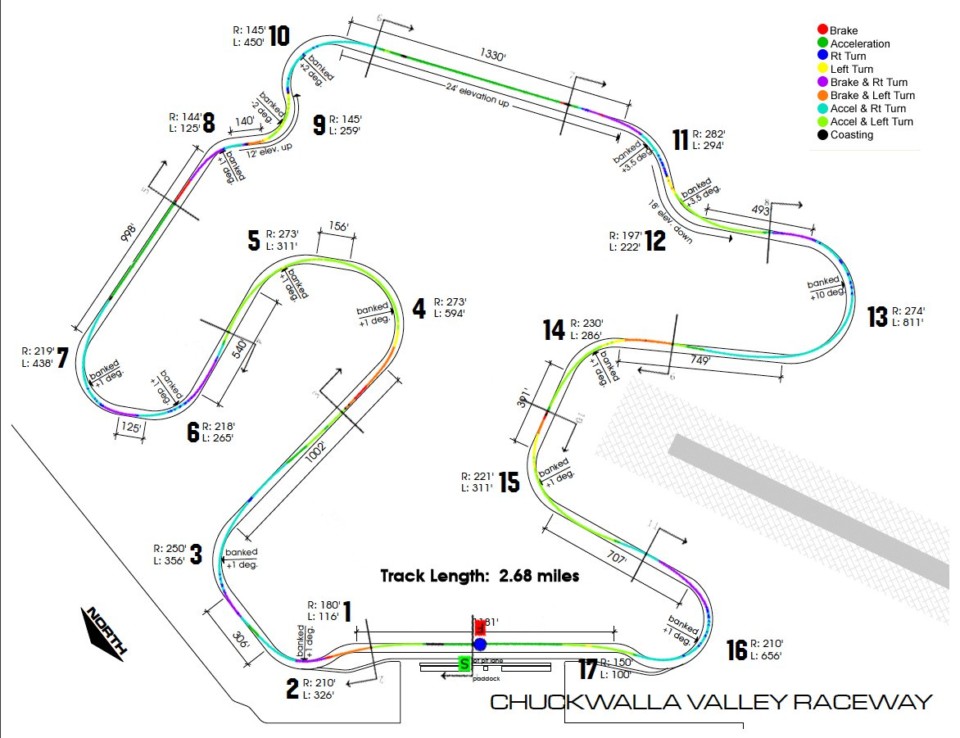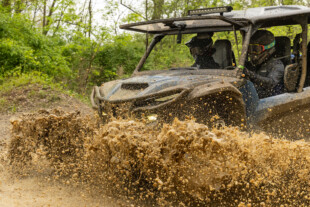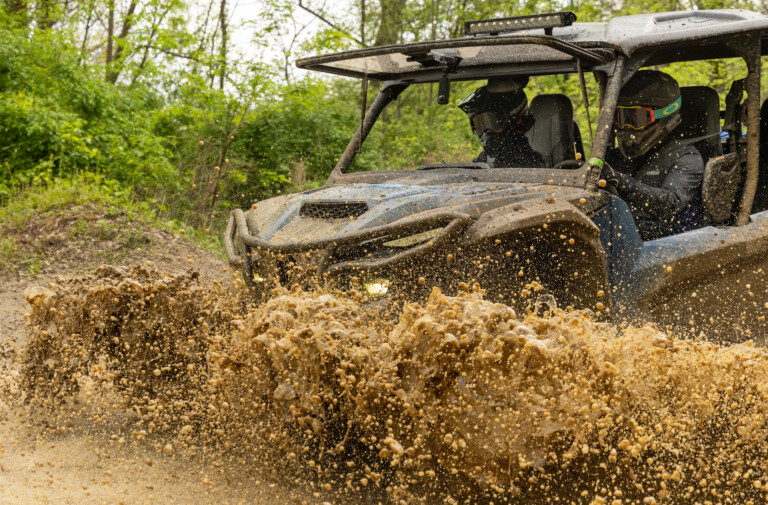
Photo credit: CaliPhotography
After more than a year in the works, my first BMW Spec E30 test was finally happening. Back in late 2017, I wrote a piece on what it takes to get the most out of BMW’s popular club racer, and it introduced me to a keen driver: Michael Mihld. Mihld, the NASA SoCal Spec E30 Champion, and I chatted about featuring his car, and eventually the discussion led into getting behind the wheel myself. For one reason or another, the test was rain-checked until a couple weekends ago. Comically, during the first day of the test, it was pouring—in the desert. Call it cosmic irony.
Mihld’s yellow BMW Spec E30 is one of the most immaculate examples of the popular club racer I’ve seen. It’s also very quick, too; this car won the NASA SoCal championship in 2017. There’s really not much better than getting into a great car on a nearly-empty track, especially when the track is as stunning as Chuckwalla Valley Raceway.
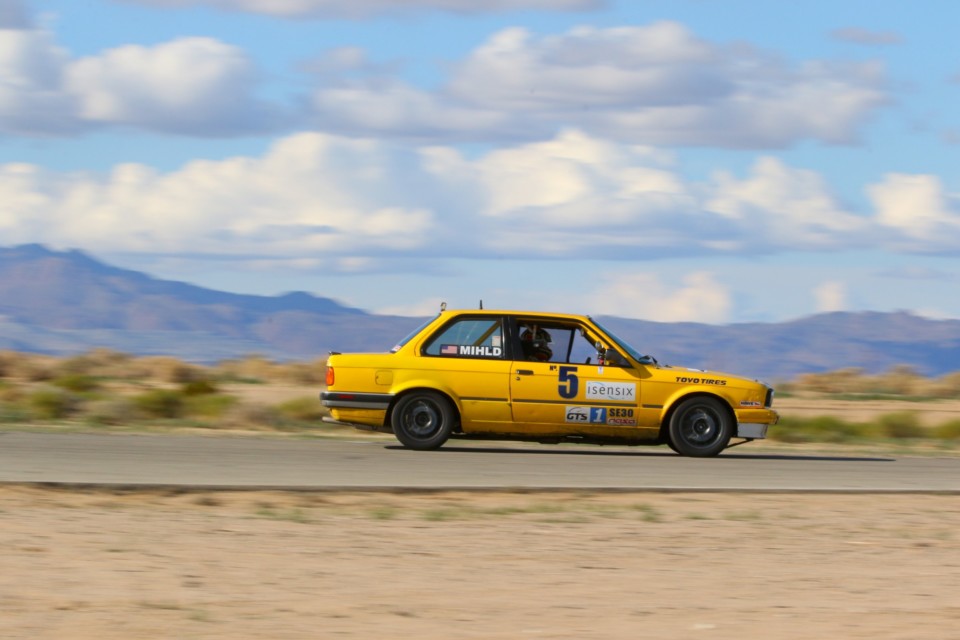
Photo credit: CaliPhotography
Excellent Track, Stunning Location
The scene made the eleven-hour, traffic-ridden, and occasionally snowy drive from San Francisco worth it. Set in picturesque Coachella Valley, Chuckwalla Valley Raceway is surrounded by haunting purple mountains, vast expanses of sky, and the large, scampering lizards for which the track is named. Long and sinuous, wide and smooth, the course offers plenty of room for experimentation. It also provides great sightlines and plenty of runoff area for when one bites off more than they can chew. The banked sections, the fast bends, the lack of barriers, and the remarkable flow all help make it a course unlike any I’ve driven. Truly, the setting could not be better for learning a new car.
A Brief Rundown on the BMW Spec E30
The Spec E30 is an interesting machine. While it isn’t nearly as responsive, grippy, or modern as some of the cars I’ve driven recently, it has a playful character of all its own. When given time to take a set and dealing with its lack of power, the Spec E30 is a fast, lively, and rewarding car to drive.
Weighing 2,550 pounds without driver, and making around 160 horsepower, it is quite the momentum car—especially since the stock gear ratios must be retained. That said, Mihld did all he could while remaining within the rules to get the most out of it. The engine was rebuilt and balanced with stock components, except in the few areas where upgrades are allowed. Included in that short list are ARP main studs and head studs, Ireland HD rocker arms, and the Spec E30-specific exhaust system. A valve job and flow-tested injectors also help rustle up the last of the available horsepower.

Though the M20 isn’t usually much to look at, Mihld’s attention to detail makes it as clean under the hood as any professional race car.
The end result is a very smooth, tractable engine with some low-end torque. While it revs at a decent speed, it doesn’t provide as much top-end zing as the bellow filling the cabin suggests. Still, there’s enough grunt to spin the rear wheels at lower speeds, and when speeds increase and the rears are torque-limited, it’s happy to dance around over bumps and curbs. Quickly, you realize how having the right suspension setup keeps this car from being frightening.
Even though the car had been refined over years of competition, Mihld forceful style made it clear how lively it still was. Hopping curbs and going full-throttle quite early, Mihld made the car break away just slightly at both axles. While Mihld looked like he was muscling the car around; fighting it through some of the corners with a good amount of opposite lock, he was actually exercising patience, precision, and planning. When it was my time to try, I was in for rude awakening.
Learning Tendencies, Changing Aims
With most of my background in karts, I admit my style isn’t always the smoothest. Sometimes I throw the thing in after turning in late; hoping it will stick and improvise when it doesn’t. Call me impatient, but with a short-wheelbased kart, it works—it even works in Spec Miatas I’ve driven. But it didn’t with the BMW. My first awkward laps were frustrating as I tried to get the car rotated early and then get back to power early, only to fall flat on my face.
Having the NASA SoCal Spec E30 Champion guiding me around the course was a treat, and a surefire way to avoid ingraining any rookie habits. Since the car didn’t have much power, the ideas he instilled were to try and 1) take the shortest lines to avoid covering unnecessary distances, and 2) commit to the throttle early, but not so early as to force a lift off the accelerator. One pays a hefty price for lifting much in a Spec E30, since 160 horsepower is not enough to salvage a botched corner. To keep the motor on the pipe through this third and fourth-gear track, a deliberate, early, and progressive throttle application was necessary.
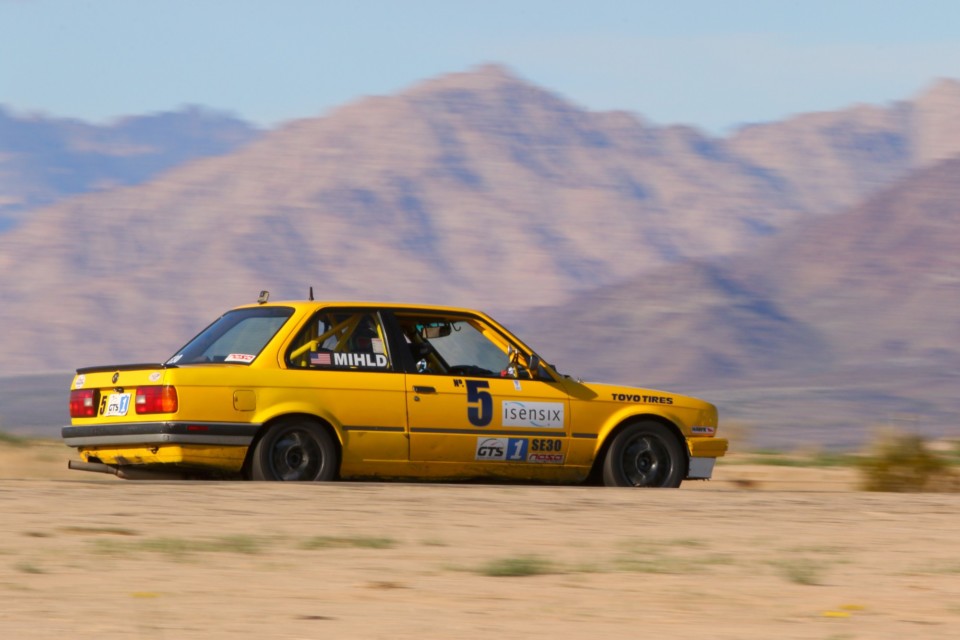
“You’ve got to learn to negotiate with the car; it won’t be bossed around,” Mihld said. Photo credit: CaliPhotography
This was a little trickier than I imagined, since Mihld’s early turn-in and gradual throttle application kept the car bound up slightly past the apex from time to time. When he’d leave some of these long corners with his foot to the floor—but with as much as thirty degrees of steering lock still cranked on, it all seemed incorrect. After all, shouldn’t the steering wheel be mostly straight once the foot is flat to the floor?
Since he was so familiar with the breakaway characteristics and transferred the weight very gradually. Kasra Ajir, a fellow Spec E30 racer and writer for TURNology, elaborated on this idiosyncrasy: “It’s a strange feeling when you can clearly feel that the load has gone away and you’re sure you’re going to push, but it just sticks!” Since the E30 uses a very slow, production-car steering rack, it doesn’t allow for the typical unwind-the-wheel-as-the-throttle-is-applied, so a small amount of understeer on exit is simply part of the experience to which one needs to adjust.
Softening Inputs and Allowing the BMW Spec E30 to Take a Set
One statement I heard several times throughout the day was that “the Spec E30 is a production car, and not a pure racing car.” Though that sounds like a denigration, it’s not—it’s just that this production car-turned-racer is still subject to a less-than-ideal center of gravity, an imperfect weight distribution, and relatively soft suspension. Though the car’s roll has been reduced with the newest Ground Control suspension package, which uses stiffer springs and a collar that allows for adjustable ride height, it still requires a specific touch. To ensure you’re using the full footprint provided by the Toyos, the E30 needs some time to roll and take a set—especially in the long corners.
Once the roll and the weight transfer are adjusted to, it starts to respond. After my first few laps, Mihld noted my steering inputs into and through the long Turn 4-5 duo were too harsh; that I was flicking the car into the corner when it needed to be eased in (0:35).
That was news to me, though it became clear he was right with a little adjustment in technique. Instead of the flick helping the rear rotate into the corner, it was making the fronts slide considerably. In the footage above, it’s clear that getting on the power and staying on the road through Turns 4 and 5 were two challenges I was barely able to juggle.

Once the car was given time to lean and take a set through Turns 4 and 5, it started responding much better. Photo credit: CaliPhotography
Noticing my trouble with these two corners, Mihld urged me to try and dial on the lock gently into and through Turn 4. So, the front tires behaved quite differently. Given more time to roll before asking much of them, the full width of their footprint was now available for use. This change carried me in tighter to the first apex, and I wasn’t struggling with anywhere as much entry understeer, which tended to worsen as the car was pushed wider onto the marbles. Finally, the E30 and I started to have a real dialogue.
Committing to the Throttle
Learning to keep the car on the intended line through Turns 4 and 5 meant committing to a steering angle and throttle application relatively early. So, after passing the first apex with the steering “locked” into position, I’d lift mid-corner after prodding the throttle; there were a few confusing times when the car nearly ran off the road!
Mihld hopped back in the driver’s seat to show me through—and made it look like child’s play. He picked up the throttle much earlier than I felt possible, but then would roll on it more decisively and progressively than I had. Where I had stabbed, he had squeezed. This kept the car right up on its toes, but with very gentle steering inputs, the car continue to trace a tight line while sliding slightly at both axles. “Think about where the car will be on corner exit,” he added. This piece of advice echoed around in my head throughout the day.
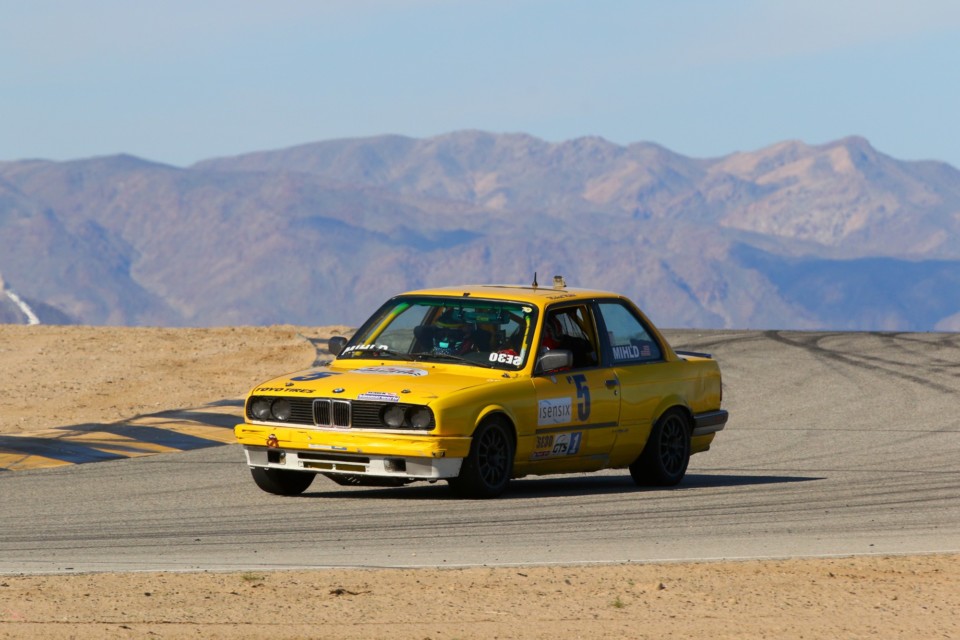
When thinking about positioning the car for the ideal exit, everything seemed to work much better. Photo credit: CaliPhotography
Back behind the wheel, I copied his throttle application to the best of my abilities. It helped the car behave more predictably, but it was one task I couldn’t quite master. Still, even with my comparatively ragged attempt, the car squatted nicely under throttle, stayed on the intended line, and just grazed the exit curbing. I was getting a sense of just how valuable it is to be as smooth as soapstone in a car like this.
Cresting Carefully and Fighting Instinct
Turn 9 threw me for another loop. After a fairly quick entry into Turn 8 (1:10), I was asked to slow the Spec E30 to a snail’s pace coming over the crest of Turn 9 (1:15). Turn 9 has two degrees of adverse camber, turns left briefly, then veers right into Turn 10, which is positively cambered, and most importantly, leads onto a long straight.
During the first few laps, the intermittent sprinkling had rendered the track a little greasy—though we still decided to run on slicks. After coming over the crest to Turn 9, I floored it. The rear snapped in a big way. Mihld, chatting with me over the comm system, casually remarked: “We’re going off” as the E30 went sideways down the hill, and it looked like I was about to park the car in the wet sand.
I threw in all the opposite lock available and somehow gathered the half-spin. Though I value his opinion, I was glad to prove him wrong in that case. Clearly, there wasn’t much grip there—even when the course dried. What’s more: Turn 10 is positively cambered and leads onto a straight. Because of these features, and the Spec E30 takes some time to roll, this would another case of sacrificing the entry in the name of a strong exit.
At such slow speeds, the urge to push the car needs to be fought. Rather charge over the hill, I crawled around Turn 9 at a frustratingly slow speed, nipped the curb, and gave the car time to take a set before the direction change, I’d taken Mihld’s advice all to heart and ignored my impulses. This way, the E30 was set up for the long right that is Turn 10, and I was able to get on the power early and hard. Countersteering slightly while the rear slithered ever so gently under full throttle, this whole weight transfer business was starting to make sense. Maybe I wasn’t that far off of Mihld’s virtuoso performance.
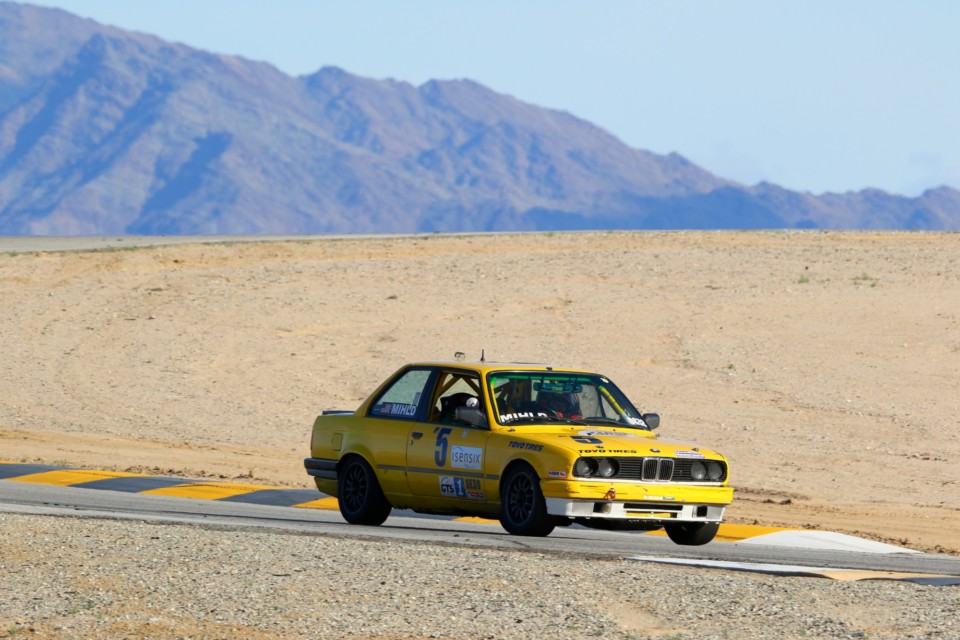
Photo credit: CaliPhotography
At the end of those two gorgeous days, I’d been able to experience one of the best Spec E30s in the country with top-notch tutelage. There were a few hairy moments, but no major off-track excursions. With the car returned in one piece, I then thanked Michael Mihld, Allan Hauser, and Justin Ross—the three dedicated racers who made this incredible weekend possible—before setting off.
Coming home over Interstate 5, there was plenty of time to contemplate the intricacies of taking a set, prioritizing the corner exit, fighting the urge to muscle the car, and trusting a front end that’s understeering at decent speeds. The car was unlike anything I’d been in, and I still managed to come to terms with it towards the end of the second day. That was a confidence-inspiring thought that helped me get over the snow-covered summit of the 4,160 foot Tejon Pass, where my rental Sentra started sliding all over the road. If I could drive a Spec E30 quickly on-track without an accident, I could manage an economy car in inclement weather. And avoid a lumbering tumbleweed the size of a cow. Without a doubt, it had been the most exciting racing weekend I’d had in a long time.


